Giovanni Boccaccio facts for kids
Quick facts for kids
Giovanni Boccaccio
|
|
|---|---|

Portrait by Raffaello Morghen, around 1822
|
|
| Born | 16 June 1313 Certaldo, Republic of Florence (now in Tuscany, Italy) |
| Died | 21 December 1375 (aged 62) Certaldo, Republic of Florence (now in Tuscany, Italy) |
| Occupation | Writer, poet |
| Nationality | Italian |
| Period | Late Middle Ages |
| Notable works | The Decameron |
| Relatives | Boccaccino di Chellino (father) Margherita de' Mardoli (stepmother) |
Giovanni Boccaccio (born June 16, 1313 – died December 21, 1375) was an important Italian writer and poet. He was a key figure in the Renaissance, a time of great change in art, literature, and science. Boccaccio was so famous that people sometimes called him "the Certaldese," after his hometown of Certaldo.
Many experts believe he was the greatest European writer of prose (regular writing, not poetry) during his time. He was very creative and mixed different writing styles to create new and exciting works.
His most famous book is The Decameron. This is a collection of short stories that became very important for Italian literature. Another well-known work is On Famous Women. Boccaccio wrote most of his stories in the everyday language of Tuscany, called Tuscan. He was known for his realistic conversations, which were different from other writers of his time.
Boccaccio's writings influenced many authors across Europe. These include Geoffrey Chaucer in England and later Miguel de Cervantes in Spain. He is considered one of the "Three Crowns" of Italian literature, along with Dante Alighieri and Francesco Petrarca. He also helped start the study of Dante's works.
Contents
Giovanni Boccaccio's Early Life
Childhood and Education

Giovanni Boccaccio's exact birthplace is not fully known. He was likely born in Florence or a nearby village called Certaldo. His father, Boccaccino di Chellino, was a merchant from Florence. His mother is unknown, and Giovanni was probably born outside of marriage. His stepmother was Margherita de' Mardoli.
Boccaccio grew up in Florence. In the 1320s, his father moved the family to Naples for his banking job. Giovanni worked as an apprentice at the bank, but he did not like it. He convinced his father to let him study law at the University of Naples. He studied law for six years, but he was more interested in science and literature.
Life in Naples and Early Writings
In Naples, Boccaccio met important people from the royal court. He fell in love with a woman who he later wrote about as "Fiammetta" in his stories. He also became friends with Niccolò Acciaioli, a powerful figure in the court.
Boccaccio did not enjoy studying law, but it allowed him to read widely and meet other scholars. During this time, he started writing poetry, which he felt was his true calling. Some of his early works include Il Filostrato and Teseida. These poems later inspired the famous English writer Geoffrey Chaucer.
Boccaccio's Adult Years and Famous Works
Return to Florence and the Black Death
Boccaccio returned to Florence in 1341. He avoided the plague that hit the city in 1340. His father had gone bankrupt and returned to Florence in 1338. Boccaccio's mother died shortly after his return.
Florence faced many challenges during this time. In 1348, the terrible Black Death arrived. This plague killed about three-quarters of the city's population. This event later became a key part of his most famous work, The Decameron.
Writing The Decameron
Boccaccio started writing The Decameron around 1349. This book tells the story of ten young people (three men and seven women) who escape Florence during the Black Death. They tell each other stories to pass the time. The book was mostly finished by 1352.
The Decameron was Boccaccio's last major work written in the Tuscan language. He revised it later in 1370–1371. This book is still very important today.
Friendship with Petrarch

In 1350, Boccaccio met Petrarch, another famous Italian writer and poet. They became very close friends. Boccaccio looked up to Petrarch as his teacher. Petrarch encouraged Boccaccio to study ancient Greek and Latin literature.
Their friendship led Boccaccio to write Genealogia deorum gentilium (Genealogy of the Pagan Gods). This book became an important guide to classical mythology for over 400 years. Boccaccio believed that even though ancient texts were about pagan gods, people could still learn a lot from them. He argued that studying old literature was important for learning and growth. This idea helped start the Renaissance.
Later Life and Writings

In 1360, Boccaccio began writing De mulieribus claris (On Famous Women). This book contained biographies of 106 famous women. He finished it in 1374.
After 1361, Boccaccio moved to Certaldo and became less involved in government work. He continued to travel for diplomatic missions, visiting places like Naples and Venice. He met Petrarch again in Venice in 1368. When Petrarch died in 1374, Boccaccio wrote a poem to remember him.
Boccaccio's health declined in his final years. He suffered from illnesses, possibly related to obesity and heart problems. He died on December 21, 1375, in Certaldo, where he is buried.
Giovanni Boccaccio's Works
Here is a list of some of Giovanni Boccaccio's important works:
- Amorosa visione (1342)
- Buccolicum carmen (1367–1369)
- Caccia di Diana (1334–1337)
- Comedia delle ninfe fiorentine (Ninfale d'Ameto, 1341–1342)
- Corbaccio (around 1365)
- De Canaria (between 1341–1345)
- De Casibus Virorum Illustrium (around 1360)
- De mulieribus claris (1361, revised until 1375)
- The Decameron (1349–52, revised 1370–1371)
- Elegia di Madonna Fiammetta (1343–1344)
- Esposizioni sopra la Comedia di Dante (1373–1374)
- Filocolo (1336–1339)
- Filostrato (1335 or 1340)
- Genealogia deorum gentilium libri (1360, revised until 1374)
- Ninfale fiesolano (between 1344–46)
- Rime (finished 1374)
- Teseida delle nozze di Emilia (before 1341)
- Trattatello in laude di Dante (1357)
- Zibaldone Magliabechiano (between 1351–1356)
See also
 In Spanish: Giovanni Boccaccio para niños
In Spanish: Giovanni Boccaccio para niños
- Influence of Italian humanism on Chaucer




